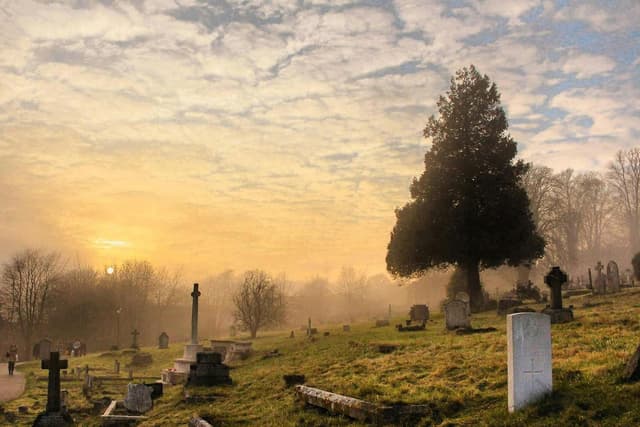The UK is home to some of the world’s most iconic burial sites, where history’s most celebrated figures rest in peace – each with their own fascinating story.
From a Scottish market town to the hallowed grounds of Westminster Abbey and the peaceful countryside of Althorp, these graves have become destinations for those wanting to pay tribute to the individuals who shaped our culture, science, literature, and politics.
But how do we know which ones truly deserve their place in the spotlight?
Thanks to the team at Funeral Guide utilising their innovative Famous Graves Finder tool, company experts have curated a list of Britain’s most renowned final resting places. The dedicated team at the UK’s largest funeral comparison site has identified the 10 most accessed famous graves on their platform, offering a fascinating look at which iconic figures continue to draw intrigue and visitors year after year.
1. William Shakespeare – Holy Trinity Church, Stratford-upon-Avon
Often called the greatest writer in the English language, William Shakespeare was laid to rest in his hometown of Stratford-upon-Avon. Despite his immense fame, little is known about his life, and even his cause of death remains a mystery, adding to the intrigue of his grave.
His grave, located inside Holy Trinity Church, is visited by over 200,000 people each year. What makes it especially intriguing is the poetic warning inscribed on his tombstone:
“Blessed be the man that spares these stones,
And cursed be he that moves my bones.”
Many believe this inscription helped preserve his grave from the exhumation and rearrangement common in later centuries.
2. Jane Austen – Winchester Cathedral
Celebrated the world over, Jane Austen remains one of Britain’s most treasured novelists, yet her work was only ever published anonymously during her lifetime. This is perhaps why her gravestone makes no mention of her literary achievements. It was not until 1870 that her nephew arranged for a bronze plaque to be placed in Winchester Cathedral acknowledging her work, with a memorial window added in 1900.
The cathedral itself receives around 365,000 visitors annually, many of whom come to pay tribute to the author of Pride and Prejudice and Sense and Sensibility.
3. Sir Isaac Newton – Westminster Abbey
Supposedly inspired by a falling apple, Isaac Newton revolutionised science with his theories of gravity, motion, and optics. His contributions shaped centuries of human progress, but his later alchemical experiments led to dangerously high levels of mercury in his body, which some believe contributed to his death.
Newton’s tomb in Westminster Abbey is an elaborate marble monument depicting him reclining on books, accompanied by cherubs. The Abbey attracts hundreds of thousands of visitors annually, many visiting the graves of famous scientists, poets, and royals.
4. Princess Diana – Althorp, Northamptonshire
Known as “the people’s princess”, Diana, Princess of Wales, was adored for her humanitarian work and compassion. Her tragic death in 1997 in a Paris car crash shook the world, leading to an unprecedented outpouring of grief.
Diana’s grave, however, is not open to the public. She was buried on a peaceful island in the lake at Althorp, her family estate, to ensure privacy. Visitors can still pay their respects at a nearby memorial on the estate grounds.
5. Winston Churchill – St. Martin’s Church, Bladon
One of Britain’s most celebrated Prime Ministers, Winston Churchill, led the country through its darkest hours during World War II. His state funeral in 1965 was the largest in the world at the time, with representatives from 112 nations in attendance.
Churchill personally chose to be buried in St. Martin’s Church in Bladon, close to his birthplace of Blenheim Palace. While his grave remains a place of quiet reflection, a grand memorial also stands in Westminster Abbey to commemorate his legacy.
6. Florence Nightingale – St. Margaret’s Church, East Wellow
Known as the “Lady with the Lamp”, Florence Nightingale transformed nursing and hospital care, particularly during the Crimean War. After setting up the world’s first secular nursing school, she continued to advocate for healthcare reform until her death at age 90.
Despite her national importance, Nightingale’s family refused a burial in Westminster Abbey, preferring a quiet resting place in St. Margaret’s Church in East Wellow, Hampshire. Unlike the grand memorials of many historical figures, her grave remains modest – just as she wished.
7. Henry VIII – St. George’s Chapel, Windsor
More infamous for his six wives than his reign, Henry VIII left behind a complex legacy. Once a handsome and athletic king, his later years were plagued by obesity and health issues. It is said that his final words were: “Monks! Monks! Monks!” – perhaps a reference to his long-fought battle with the Catholic Church.
Despite his historical significance, Henry’s burial is surprisingly modest. He rests in St. George’s Chapel, Windsor, next to his third wife, Jane Seymour, the only one to give him a male heir. Windsor Castle receives millions of visitors annually, many of whom explore the chapel’s royal tombs.
8. Robert Burns – St. Michael’s Churchyard, Dumfries
Robert Burns, often hailed as Scotland’s national poet, gave voice to the spirit of Scottish culture through his works, written in a blend of Scots, English, and local dialects. His poignant poetry captured the hearts and souls of the Scottish people, leaving a lasting legacy that continues to resonate today. Burns passed away in 1796, his health deteriorating due to a heart condition.
Initially, his widow chose a modest stone slab for his grave, but it quickly became clear that such a simple marker was insufficient for the man whose words had shaped the nation. In 1817, nearly two decades after his death, Burns’ remains were relocated to a more prominent spot within the churchyard, and a magnificent mausoleum was constructed in his honour – a fitting tribute to Scotland’s literary icon.
9. Amy Winehouse – Edgwarebury Cemetery
A soul diva whose smoky vocals and raw lyrics captivated the world, Amy Winehouse achieved legendary status long before her untimely death at age 27. Her second album, Back to Black, propelled her to global fame, yet she struggled with personal demons.
Winehouse died at her Camden home and was cremated at Golders Green Crematorium. Her ashes were later interred at Edgwarebury Lane Cemetery, where her family and fans continue to remember her.
10. Ebenezer Scrooge – St. Chad’s Church, Shrewsbury
While Ebenezer Scrooge is a fictional character from A Christmas Carol, his lichen-covered and cracked gravestone in St. Chad’s Churchyard, Shrewsbury, has become an unexpected tourist attraction.
The gravestone was created for the 1984 film adaptation starring George C. Scott as Scrooge. When filming ended, the stone was left in place, and over time, it became a popular curiosity for Dickens enthusiasts and visitors to the historic town.































